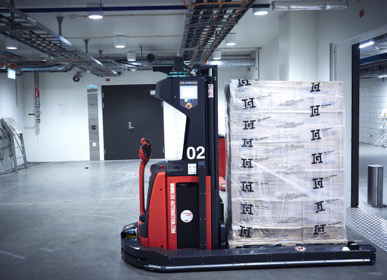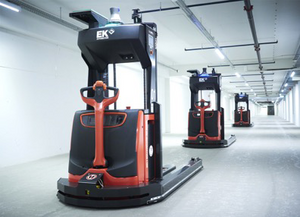Any passenger at the airport opt for a stop at the duty free shop. They always expect the shelves to be filled with wine and liquor, cosmetics and sweets. This requires the smooth-functioning flow of goods – a special challenge for the shop operators, because any logistics concept within the security area of an airport is subject to stringent regulations. Gebr. Heinemann of Hamburg operates one of Europe’s biggest duty free shops at the new international terminal of the Oslo Airport that opened in 2017. The goods for this shop are delivered from the main warehouse in Hamburg to the airport’s goods receipt department. From there, they have to be transported to the duty free shops according to demand.
First transport robotics system at an airport
For the efficient supply of goods, the operator of the shops, Gebr. Heinemann, required an automated transport solution and decided to introduce the world’s first driverless transport system into its duty free area at Oslo airport. Gebr. Heinemann chose EK Automation based in Rosengarten near Hamburg to implement the solution. With about 180 employees worldwide, the company specialises in Automated Guided Vehicle (AGV) and materials handling systems, and is one of Europe's leading manufacturers of driverless transport systems (DTS), also known as transport robots. The specialists at EK Automation develop intelligent and efficient transport robotics solutions that are customised to individual requirements.
Felix Schad, the EK Automation project manager for this job, describes the special challenges of this project: “The pallets have to be transported over several levels by using elevators and by driving through long, narrow passageways at the Oslo Airport. This takes place in different security areas of the airport. It is therefore necessary that the goods will not be manipulated during their transport passages. Gebr. Heinemann decided to work with EK Automation for the implementation of a 3D simulation to develop the ideal transport concept and to determine the optimum number of transport robots. A model of the AGV system simulated different versions of the process flows, from which the best solution was chosen. The simulation made it possible to identify unforeseen challenges, planning risks and bottlenecks. Thanks to the simulation tool, the company was able to realize their automated transport system at its optimum and to achieve maximum efficiency, despite all its special requirements and circumstances.
Based on the simulation results, it was possible to determine the right number of automated guided vehicles needed for this transport solution, means the material flow crossing several airport areas with direction to the ‘departure area’. For this purpose, the specialists modified standard forklifts. These forklifts were retrofitted with straddle legs and equipped with a laser navigation system.
The goods will be transported on pallets from the airport’s goods receipt department to the delivery points. In order to pick up the pallets, the AGV control system sends signals to the vehicles for starting collection of the goods and their transport way to the shops. The transport control system from EK Automation remains permanently in communication with the vehicles at every point along the route.
Innovative light barrier sensor protects goods
The AGVs are equipped with a unique security system. “EK Automation transport robots protect the pallets by using an innovative sensor solution that creates a light barrier around the goods. This enables immediate detection of any intervention during transport through the supply passageways. In this case, an alert is sent and the transport robot drives to a checkpoint, where security employees can initiate the necessary measures” Felix Schad explains.
Custom service plan, short response times
Another requirement of the project was to create a customised service concept to guarantee short response times for the operators of the duty free shops, including the fast supply of spare and wear parts. EK Automation provides a 24/7 hotline for the customers in Oslo. In the event of a service call, the specialists in Rosengarten first establish a remote maintenance connection to decide whether the problem can be solved via remote control or if a service engineer is required on site. For this purpose, EK Automation has engaged a local service partner who can be at the airport within two to four hours. “It has proven worthwhile to integrate and qualify this partner in the very early stages of the project. The service calls that have been necessary so far confirm the smooth-functioning chain in cooperation with the client and the local partner,” according to Marco Bemmlotte, Head of Customer Relationship Management at EK Automation.
In retrospect, Felix Schad and Marco Bemmlotte, they both agree that the cooperation of the various partners was a major factor for the success of this demanding transport robotics project. The client, Marco Rebohm, Director Global Logistics at Gebr. Heinemann, likewise draws a positive conclusion: “The AGV that we developed in cooperation with our project partner EK Automation, with an integral analysis of all relevant processes and requirements, provides for the efficient and reliable transport of goods in a structurally restrictive and highly dynamic environment. At the same time, the innovative scanner technology ensures the tamper-proof transport of goods within the security area in adherence to the regulations.”



















